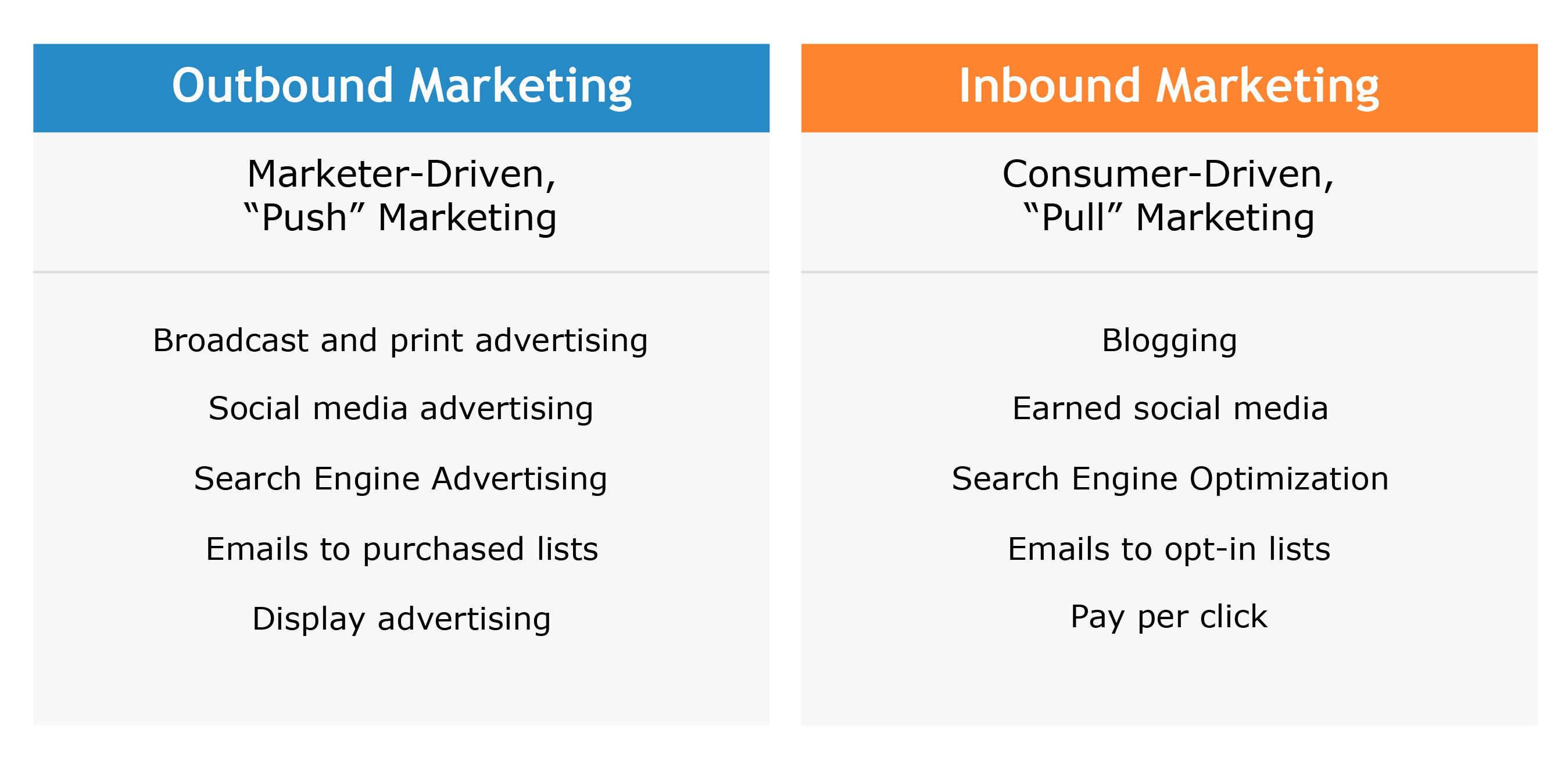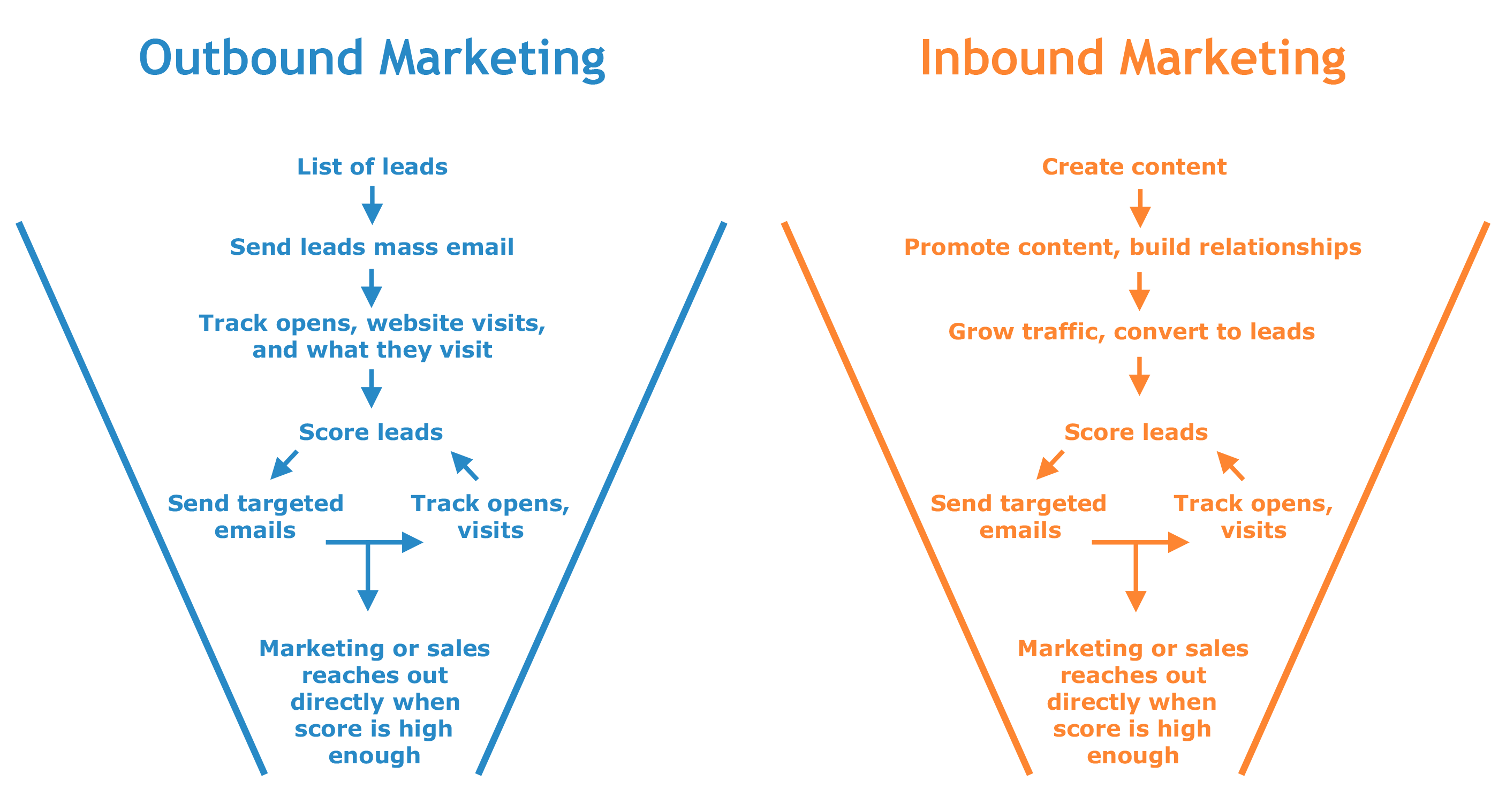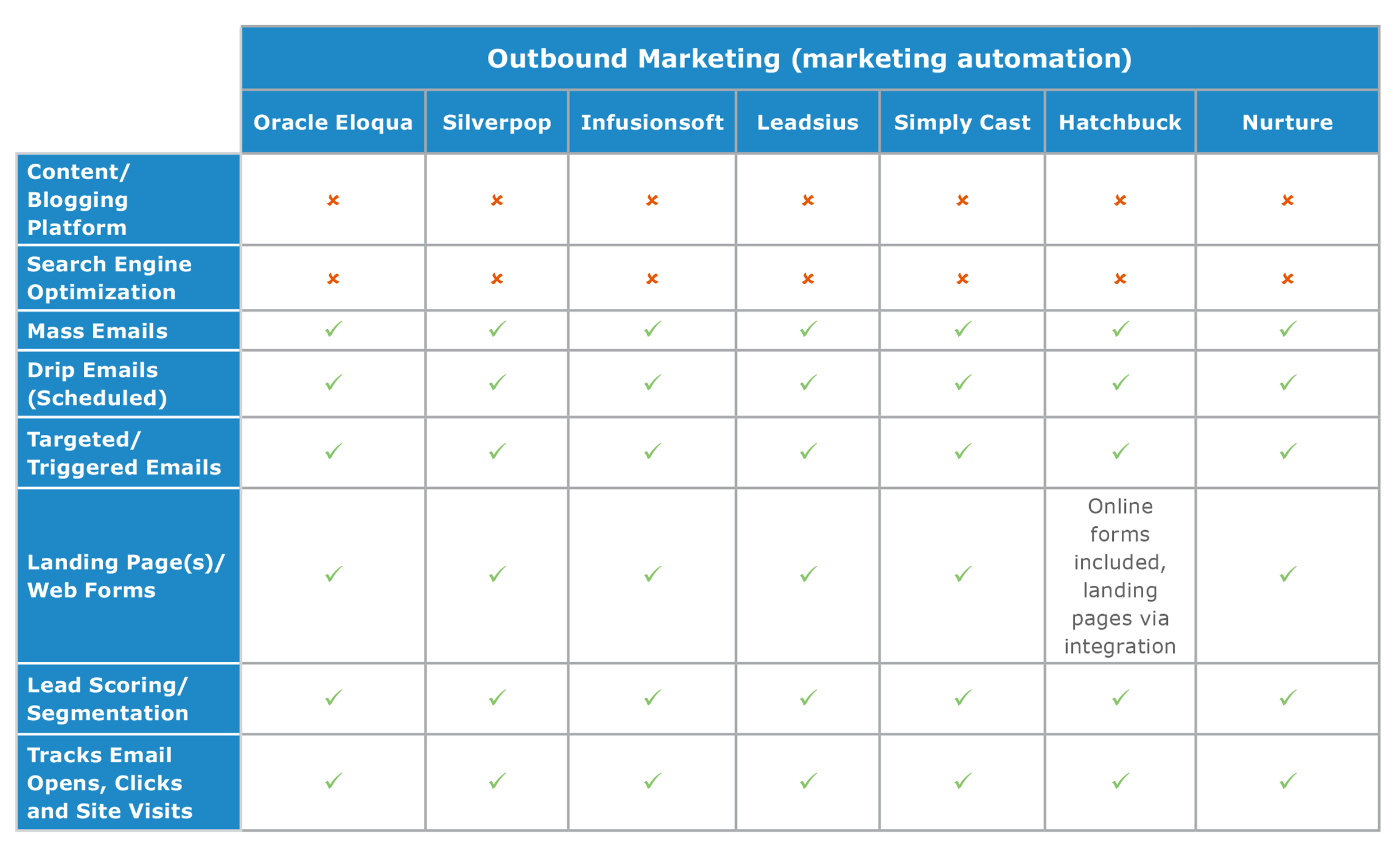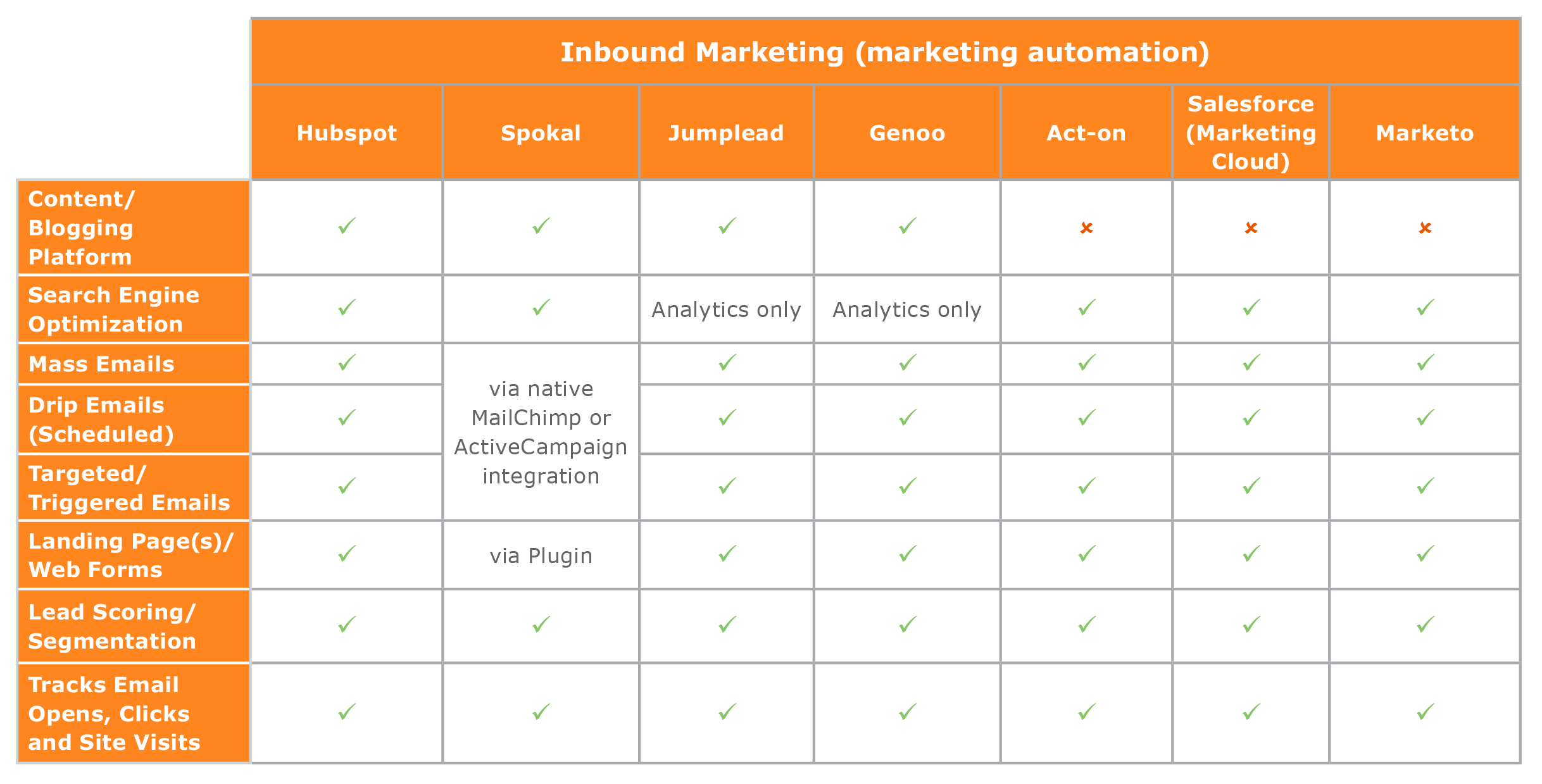Inbound vs Outbound Marketing: A Primer for Newbies or Switchers
There are two basic types of marketing—outbound and inbound.
There’s a lot of buzz around these terms, but what do they really mean? And what tools do you need to be a successful outbound or inbound marketer?
These questions can be difficult to answer if you’re new to marketing, or even if you’re considering switching from one strategy to the other.
To help, we’ll walk you through the basics of outbound and inbound marketing and provide some tips on what kinds of tools work best for both types.
Here’s what we’ll cover:
What’s the Difference Between Outbound and Inbound?
Choosing the Right Tools for the Job
Examples of Software for Outbound and Inbound
Tips for Switching from Outbound to Inbound
What’s the Difference between Outbound and Inbound?
Outbound marketing—also called “push marketing” or “interruption marketing”—is when a marketer contacts prospects, hoping for engagement.
You can think of outbound marketing as any type of marketing message that proactively initiates the conversation with a potential customer.
Tactics include:
Advertising on search engines
Paying publishers of websites to post your ads (aka “pay per click,” or PPC)
Commercials
Cold calls
Sending emails to a list of leads
Example: A real estate agent gathers leads from open houses, website visitors who subscribe to their mailing list and by purchasing leads from Zillow, a real estate website. The realtor emails her monthly newsletter to these leads and advertises her services on Zillow, hoping homebuyers will respond.
Inbound marketing—also called “pull advertising”—helps customers find you, rather than you seeking them out. Marketers using inbound methods don’t interrupt a prospect’s flow. Rather, they prioritize placing compelling content where prospects are likely to find it organically.
This is usually done by providing interesting, helpful content on websites, blogs or social media that engages buyers. Inbound marketers optimize web pages to rank higher in search engine results so buyers are more likely to find them (called “search engine optimization,” or SEO).
Example: A realtor maintains a blog where she writes about local real estate trends and factors to consider when buying a home. She shares this content on social media networks. Local homebuyers see her posts and find them helpful. They contact her to ask more questions, giving her the opportunity to build a meaningful, ongoing relationship as a trusted source of information.
Examples of Outbound and Inbound Marketing Tactics

What Strategy Should You Use?
The short answer: It depends on your current situation, available resources and future goals.
A good way to think about this is to understand the pros and cons of each strategy. This will help you understand whether you should stay with your current strategy or make the switch to another.
Pros of Outbound Marketing
Outbound marketing is easier on the front end. It’s a simple strategy if you already have a large number of leads and you’re satisfied with the quality of your leads.
Outbound marketers simply produce one-size-fits all content and distribute it en masse to all their contacts. Then, they wait for click-throughs. Piece of cake.
If you don’t have the time and/or skills (or want to learn the skills) to create a bunch of high quality content, outbound marketing is a safe way to go.
Cons of Outbound Marketing
With outbound marketing, not all those who engage will be ready to buy. For example: It’s really easy for me to click a link in a marketing email simply because I’m curious to learn more. I may not be at all interested in making a purchase.
It’s up to the outbound marketer to separate the wheat from the chaff. This can be a time-consuming process. If you’re not satisfied with the quality of your leads, or you’re struggling to manage a large volume of leads, consider inbound marketing.
Pros of Inbound Marketing
Prospects who seek out content that addresses their pain points and make contact as a result are more likely to be lower in the buyer funnel than a lead who is contacted out of the blue.
For this reason, leads acquired from inbound marketing tend to be higher quality (i.e., warmer leads), so inbound marketers spend less time and energy converting them into paying customers.

“[Inbound] leads are self-selecting. Instead of pushing out and trying to identify who you think might be in the market to buy, the people who are out to buy are basically coming and telling you that they are in the market. In theory, at least, you are skipping a lot of the time-wasters.”
Chris Mack, founder of Spokal
In other words, the content does the initial legwork to nurture the relationship.
Cons of Inbound Marketing
On the other hand, for content to be successful at drawing buyers in, it must be meaningful and useful to the target audience. This means inbound marketers must put in more work at the start when creating their content.
Inbound marketers must also wait for content to resonate and for buyers to reach out. Inbound marketing doesn’t generate results overnight.

“It generally takes six to 12 months before you start seeing a decent return [with inbound marketing]. Once we’ve got the site up and running and it’s established and it has traffic, we can stop putting work into it for a month or two—and it’s still going to deliver leads regularly.”
Chris Mack, founder of Spokal
That said, neither strategy is inherently better than the other. What’s most important is to choose which one meshes best with your current needs and aligns with your future goals.
Consider these questions:
What is your current lead situation?
What is the target audience you want to reach?
What lines of communication do you want to use?
What kind of content do you want to produce?
This will also help you choose the best tools to support your process.
Here’s a handy overview of everything we just discussed:
| Outbound Marketing | Inbound Marketing |
Lead situation | You already have a good source of leads or work with purchased lists. | You want to acquire leads by creating interesting, relevant content. |
Time spent | You’ll reach many leads right away and are willing to spend time sorting through a high volume of leads. | You’re willing to wait for up to 6-12 months for leads to come in, but you’ll spend less time sorting through leads. |
Target market | Homogenous: Majority of customers hold similar preferences. | Complex or less uniform: Customers vary greatly in their preferences. |
Communication | One-way | Interactive, two-way |
Content type | Generic, mass distributed | Tailored, targeted |
Choosing the Right Tools for the Job
The easiest way to understand how software supports these two strategies is to visualize the marketing funnel associated with each:
Outbound and Inbound Marketing Funnels

Source: Spokal
In the outbound marketing funnel, a steady source of leads are filtered through. In the inbound marketing funnel, content is generated and distributed and it attracts the interest of buyers, allowing marketers or salespeople to build relationships with them.
Ultimately, the right tools for the job are those that support the way the marketer wants to handle their leads:
Outbound marketing software. Look for software solutions with functionality to help you easily distribute content en masse to your existing contacts.
The tool you select should also provide ways for you to capture leads that come in from your outbound marketing communication (e.g., a link to a landing page in your mass emails).
Finally, look for capabilities that will allow you to filter your leads and identify the most promising ones, such as lead segmentation and lead scoring.
Inbound marketing software. Look for functionality that will help you craft rich, engaging content and place that content in front of the right eyes.
Your solution should also provide tools for assessing how well your content is performing with your target markets, along with functionality to help you to judge the quality of your leads.
Valuable Software Functions
Outbound Marketing Software | Inbound Marketing Software |
• Send mass and drip emails • Landing page creation • Track email opens and site visits • Lead scoring/segmentation | • Send targeted emails • Website/content management • SEO tools • Lead scoring/segmentation |
The two software systems most used for marketing are:
Email marketing software: Primarily used for outbound marketing
Marketing automation software: Used for both inbound and outbound marketing
It sounds simple, but choosing the right marketing software can still be tricky.
First, there’s often confusion about the difference between the two types. This is due, in part, to the language some software vendors use. For example, some email marketing vendors will describe their software as “automated email marketing software.”
Second, not all marketing software vendors use the terms “outbound” or “inbound” to describe what their software does.
While many marketing automation systems support both outbound and inbound marketing strategies, some focus primarily on outbound marketing.
And while email marketing software really only supports outbound marketing, it is possible to combine email marketing software with other tools (such as blogging software, SEO tools and/or social media marketing software) to implement a successful inbound methodology.
We clear up some of the confusion about the two types of systems in this article. If you’re struggling, it’s worth a read to understand what each software offers.
In the next section, we’ll provide some examples of specific solutions to help you choose the right software for your chosen strategy.
Examples of Software for Outbound and Inbound Marketing
For outbound marketing, you have your pick. Any email marketing or marketing automation system can be used for outbound marketing.
Depending on the functionality offered, marketing automation systems can be used for either outbound or inbound marketing. Below are some examples of marketing automation vendors that offer at least some of the functionality discussed above.
Vendor Comparison: Outbound Marketing

Vendor Comparison: Inbound Marketing

NOTE: These tables do not represent a ranking of products, but rather a sampling of available offerings on the market. All of the information is publically available online, drawn from product brochures, data sheets, vendor websites, instructional manuals, case studies, knowledge bases and support forums.
Tips for “Switchers”: Going from Outbound to Inbound
Because inbound marketing requires more energy and effort up-front, it’s a bit trickier of a ball to get rolling, particularly if you’ve been using outbound methods for a while.
As we’ve said, outbound content is generally one-size-fits all. One piece of content is shared with everyone.
Inbound content, on the other hand, aims to address more specific and nuanced buyer pain points and questions. Thus, not only must inbound marketers create more kinds of content, they must also decide how to focus it for different target audiences and promote it.
Maybe you’ve heard the hype lately about ditching outbound for inbound, but you don’t know where to start. Those of you who have been practicing outbound marketing, but want to make the leap to inbound, might be feeling overwhelmed about starting the process.
Never fear; Software Advice is here! We’ve put together a list of our favorite tips for smooth switching:
✔ Know your target audience. Do some research to get a feel for your target audience’s interests and pain points. Understand what channels they use to find information and in what ways they prefer to communicate. Do keyword research (with Google Adwords, for example) so you’ll know how to optimize your inbound content with the keywords most likely to drive new traffic to your website.
✔ Don’t rush content creation. The key to successful inbound content is relevancy. Take your time crafting meaningful content that address real buyer pain points, educates buyers and establishes you as a source of useful information. This due diligence up front is well worth the effort and attention.
✔ Cultivate a social media presence. Social media is a great place to share your content and also develop organic relationships with prospects. When used artfully (i.e., no hard selling), it makes for a friendly, intimate way to connect and converse with buyers. For more on how to use social media successfully, read our article on social selling.
✔ Be patient. Understand that it takes time to get inbound marketing rolling. It’s not uncommon for there to be a lag time between content distribution and the closing of leads. For example, some experts suggest it could take six months to a year to see a full return on investment. Stay the course and in the meantime, keep producing and sharing awesome content.
✔ Get salespeople on the inbound train. Great content can lead a potential customer to contact a salesperson, but they may have additional pre-purchase concerns that need to be addressed before they pull the trigger. Salespeople can use your content to address a specific buyer’s questions and help nurture them down the funnel. For more on how this works, check out our article on “Smarketing.”
Next Steps
Need help choosing the right marketing solution? Here are a couple steps you can take to narrow down your options and get more information:
Email me at lukewallace@softwareadvice.com. I’m available to help you start the software selection process, or to answer any additional questions you might have about inbound or outbound marketing.
Check out detailed comparisons and real user reviews of popular marketing software.